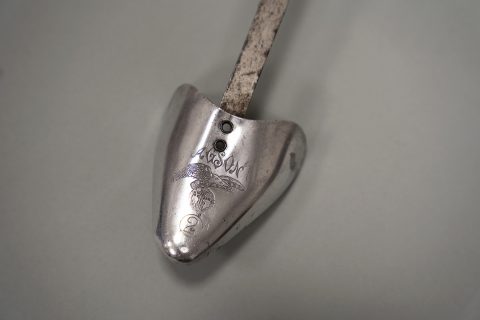Martynas Kosas, the restorer at the Kaunas Ninth Fort Museum, invites you back to his workshop in this week’s Museum Wednesday column.
Even though one may think that modern plastic products as we know them today only emerged at the end of the 20th century and have spread massively as cheap products from China, this is not the case. The origins of plastic date back to the end of the 19th century, when many European and American chemists were experimenting with different types of rubber and residues of chemical compounds.
In 1865, John W. Hyatt patented a process for combining cellulose nitrate and camphor and called the resulting compound “celluloid.” It was used instead of ivory in the manufacture of billiard balls, as well as in the production of photographic film and motion pictures.
In 1907, chemist Leo Hendrik Baekeland developed the technology to produce bakelite. Bakelite was the first plastic made from synthetic materials. First, it was used as an insulating material in military and civilian radiotechnics, electrical engineering and various military products. Later, it was noted that due to its ease of painting and carving, it is suitable for decoration and jewellery making. Bakelite was painted in various colours and carved with all sorts of patterns: flowers, fruit, animals, Egyptian-style patterns or geometric shapes. It was cheap to make such jewellery; it was colourful and affordable for everyone. For example, during the Great Depression in the USA, they became an important element of women’s costumes.
In Lithuania, there is no specialty of a plastic restorer; therefore, it was impossible to consult with a local colleague.
In the Russian Empire, plastic was also created by local chemists, using the already discovered Western technologies. They invented (or rather reused the inventions of their Western colleagues) a simplified analogue of bakelite – carbonylite. In 1916, a factory called “Karbolit” was set up in the Moscow province. In 1919, like all private companies at that time, it was nationalised by the Bolsheviks. Plastic production itself was also taken over, but its quality did not change for the better over the years. Incidentally, it was in this factory that the dark brown or black carbolite lamp was developed, which became known as the “NKVD lamp.”
The original plastic mouldings remained virtually unchanged until 1946. After WWII, in Europe, which was devastated and destroyed during the war, there was a huge demand for inexpensive and mass-produced plastic items. James Hendry built the first screw moulding machine and revolutionised the plastic industry. This invention made the production of plastic products cheaper, and it was possible to produce them quickly and in large quantities. In the post-war period, the Soviet Union took over the production of such products, which were mainly made in plastic factories set up on the basis of dismantled factories in Germany, using Western technologies and inventions. Most factories were concentrated in the same place as the dense network of GULAG labour camps, where the free labour force was concentrated.
The collections of Kaunas Ninth Fort Museum contain an example of a post-war mass-produced plastic product: a plate made in Novosibirsk, at the factory “Plastmass” at around 1950. The dimensions of the plate are 29x20x5 cm. It is made of pink-coloured carbolite by hot pressing. The factory mark is hot-stamped on its bottom. This is one of the household articles produced in large quantities and on a massive scale at that time. The plate, which was handed over to the museum in 1989 and is preserved in the collections, was used by the family of deportee Anelė Petrauskaitė-Skubienė. She claimed that the plate was used in her family to store meat.


The object reached the restorer’s workshop in very poor condition. The entire surface was covered with dirt, blackened and scratched. It was obvious that the plate had been used intensively for its intended purpose for many years, as the multiple knife cuts indicated that it had been used to cut meat or other foods, as its owner mentioned.
An object made of plastic or other synthetic materials before or shortly after WWII may already qualify as an antique. Collectors of antiques, aware of the value of early plastic products, have been collecting such items. These can range from militaristic items from WWII to toys and household items produced after the war. Although thousands of such items were produced, only a few have survived. At the time, their massive scale and cheapness meant that they were available to everyone; therefore, they were not valued. Many of these items were easily discarded as obsolete and unnecessary. Thus, those that have survived to the present day have their value if they are still in good condition.


Western countries began training restorers who study, conserve and restore plastic-based artefacts more than a decade ago. In Lithuania, there is no specialty of a plastic restorer; therefore, it was impossible to consult with a local colleague on how to carry out conservation work and to what extent the original image of the exhibit can be restored. It was necessary to spend days looking for information on foreign restorers’ websites, reading specific literature and trying it all out in practice. Using contemporary technologies, it is possible to restore plastic to a state where it looks as if it was made yesterday, but this was not necessary for the museum exhibit that dates back to the deportations. It was decided to clean off the accumulated dirt and coating, but to leave the obvious signs of use. The surface was degreased and cleaned with various conservation-restoration chemicals. After that, the entire surface was heated, coated and polished with synthetic microcrystalline wax. The work was carried out as many times as necessary until the desired result was obtained.




